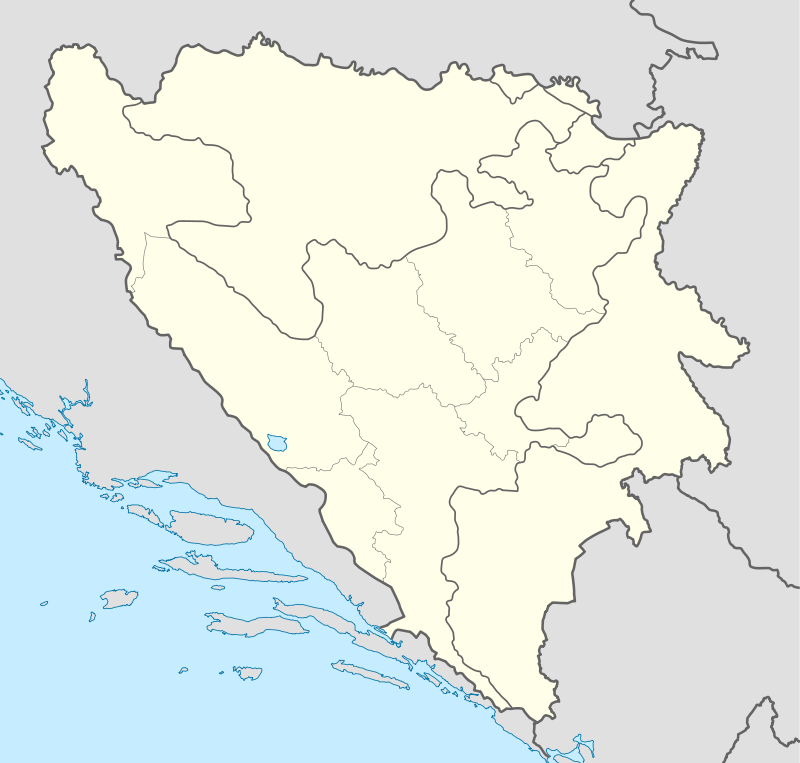Gornje Vodičevo
| Gornje Vodičevo | |
|---|---|
| Village | |
 Gornje Vodičevo | |
| Coordinates: 45°07′32″N 16°29′06″E / 45.12556°N 16.48500°E | |
| Country |
|
| Entity |
|
| Municipality | Novi Grad |
| Area | |
| • Total | 10 sq mi (25 km2) |
| Time zone | CET (UTC+1) |
| • Summer (DST) | CEST (UTC+2) |
Gornje Vodičevo (Serbian: Горње Водичево) is a village in the municipality of Novi Grad, Republika Srpska, Bosnia and Herzegovina.[1] It consists of twenty hamlets; among them are Kukavice, Vukovići, Kestenova Dolina, Bundale, Rekići, Potok, Žljeba, Šurlani (Stanići), Kolundžije, and Đurđevići-Zecovi.
History
County Vodice and village Vodičevo were mentioned for the first time in 1197 and, after that, in 1200. This county belonged to the Babonici princes.[2]
Count Stephen of Gorica of the Babonici family, who was awarded the estate of Vodičevo in Bosnia for his successful defence of the border in Bela Krajina, ceded part of this estate to the Templars before 1210.[3]
During the Turkish rule, Gornje Vodičevo was mentioned as a village in Kostajnica nahija (sub-district) in 1604.[4] A sign of the Turkish rule over this region are ruins of a fortress which was 4m long, 2m wide (inner dimensions) and 7m high made of stone. The fortress walls were 65–70 cm thick.[5] The fortress was located on the north side of hamlets Bundale and Rekići and on the right bank of the water stream called Vodičevo River.
During the second World War this village was known by their organized resistance to foreign occupation.[6][7][8]
According to a Yugoslav federal census as of 1948, this village had 142 homes and 750 inhabitants.[9]
Geography
A geological study of Gornje Vodičevo[10] was commissioned by Austro-Hungarian government in 1902. It was discovered that the village has large deposits of coal.
Customs and beliefs
Serbs of Bosnian Krajina believe that hazel protects men against lightning strike and that this tree belongs to Perun, the god of thunder and lightning. In this village, on account of this belief, people, after receiving Communion, eat hazelnuts that must be cracked only by stone.[11]
References
- ↑ Official results from the book: Ethnic composition of Bosnia-Herzegovina population, by municipalities and settlements, 1991. census, Zavod za statistiku Bosne i Hercegovine - Bilten no.234, Sarajevo 1991.
- ↑ Dragomir Vukičić, Asim Peco, Nevenka Gošić; Zbornik referata i materijala V jugoslovenske onomastičke konferencije , Akademija nauka i umjetnosti Bosne i Hercegovine, 1985 page 79
- ↑ The Crusades and the Military Orders: Expanding the Frontiers of Medieval Latin Christianity by Zsolt Hunyadi, József Laszlovszky, Central European University Press, 2001 page 136
- ↑ Mirela Slukan Altić: Državni arhiv Bjelovar, page 56
- ↑ Mihić 1981 page 289
- ↑ Ratno djetinjstvo: zbornik dokumenata i sjećanja o postanku, razvoju i radu saveza pionira u Bosni i Hercegovini, Svjetlost Sarajevo, 1961 page 62
Najveći pionirski odred bio je u selu Gornje Vodičevo. U njemu je bilo sto pionira. Prvi rukovodioci toga odreda bili su najaktívniji pioniri (Ljuban M. Kolundžija i Rade M. Zec). Pioniri okupljeni u svoje organizacije učili su da čitaju i pišu, pomagali su članovima narodnih odbora u selu u prikupljanju hrane za NOV - ↑ Kozara: priroda, čovjek, istorija by Ljubo Mihić
Dnevnik, 1981 page 778
4. brigada krenula je pravcem selo Svodna-Agino polje-Pošta brdo-selo Lješljani-selo Gornje Vodičevo, gdje se razmjestila u rezervu divizije - ↑ Milorad Vignjević: Kozara u narodnooslobodilačkom ratu: Zapisi i sjećanja. Sjećanja prikupio Milorad Vignjević, Volume 1, Vojnoizdavački zavod, 1971, page 502
Још у току фронталних борби, почетком августа 1941, створен је и први народноослободилачки одбор у селу Горње Водичево (за Водичево, Добрљин и Куљане). Он се бринуо о исхрани одреда и избјеглог становништва. - ↑ Konačni rezultati popisa stanovništva od 15 marta 1948 godine, Book 1, Savezni zavod za statistiku (Yugoslavia) SZS, 1951 page 305
- ↑ Wissenschaftliche Mitteilungen aus Bosnien und der Herzegowina, Volume 8, Das Museum, 1902, 27. Das kohlevorkommen von Vodicevo, III Naturwissenschaft chapter pages 372-373
- ↑ Шпиро Кулишић: О светковању четвртка (De la celebration du jeudi), Glasnik: Bulletin, Volume 14, Etnografski muzej u Beogradu, 1939 page 95
Sources
- Borislav P. Đukić, Milivoj Rodić: Vodičevo: vijekovima na granici imperija; Viktorija, 2007
Coordinates: 45°07′32″N 16°29′06″E / 45.12556°N 16.48500°E